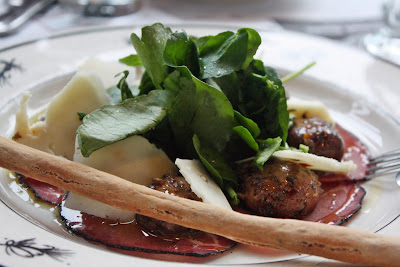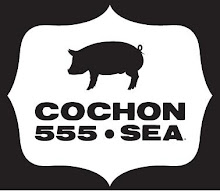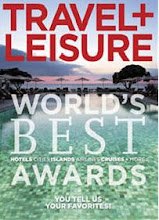I sent the following post to Crescent before I hit "publish". (Call it a courtesy preview....)
Fresh off a teaching gig at Mexico's famous
Rancho La Puerta, Crescent reviewed the post, and as usual, chimed in with her own comments. She has given me permission to share our exchange...and her comments are in itallics.
***
Award-winning author
Crescent Dragonwagon and I have been friends for years. While we don’t see each other much, Crescent has taught me the beauty of regularly scheduled phone calls. We block out an hour or more; she fixes a pot of tea, and over the phone, we settle in for a long and lingering conversation. Inevitably, she bestows a wheelbarrow full of wisdom that keeps me pondering for weeks.
Our first encounter was in the spring. Touring Seattle, we stopped a favorite park, wedged between a freeway and the edge of Chinatown. A swath of cherry trees were in full bloom and shafts of sunlight found us...lingering under a shower of blossoms.
[Crescent:
Traca commented that it was like being under a huge frilly ante-bellum skirt, and it was! We also visited with some Japanese community gardeners, very old, non-English speaking. Perhaps because neither she nor I ever take a day off, it was pure enchantment for both of us.]
Spring is bold and vibrant, and in my mind, forever linked to Crescent. Since I’ve got her on my mind, I thought I’d share:
11 Things I Learned from Crescent Dragonwagon1. Embrace your weird ass name. As Crescent tells it, in a bold and defiant move she chose her name during her “hippy dippy days”. Although I did not choose my name, it has its own colorful history. Below the surface, both our names reveal so much more.
[Crescent:
Well, at the time I thought I was a radical, not a hippie... the full story's here. I don't know if I embrace my wierd-ass name so much as I do live with it, including my ambivalence.]
2. Money in publishing is a nebulous thing. Write anyway.
[Crescent:
YES! Traca, if you got this from me, and if anyone else gets it from me via you, we've added major credit to our karmic American Express accounts.]
3. When it comes to photography, we’re like the odd couple. I photograph everything. She photographs nothing. As a skilled observer, I’m convinced she “sees” more. (I lean on the image; she expresses it through words.)
[Crescent:
Aw. This is nice, Traca. Of course, we have to mention my partner, David, who IS willing to photograph for me these days, much better than I could, so I've come over to your point of view somewhat. But, people, I'm convinced we all see in different ways, have different natural gifts in what and how we see, which we then have the option to develop. Or not. Traca and I both take our natural gifts and inclinations and push 'em to a point some might call obsessive.]
4. An infinity sign and a bit of wisdom changed my life. Crescent tells me: We are all on the infinity path. Sometimes you’re on a peak. Sometimes you’re in a valley. Embrace them both. They’re equally valuable steps in the process.
[Crescent:
Because, you know, whether or not we embrace the unpleasant, difficult, heartbreaking stuff --- we get it. So best to embrace, which doesn't mean like, it, since there it is. Once we quit pathologizing (it's WRONG to feel badly or be in a tough unfair situation at times, rather than seeing it as a natural part of life, from which no life is exempt) the resistance ends ... and with it a whole layer of pain. You may still hurt, but not so badly, and WITH utility --- with a sense that you can use the suffering/hurt/fear/loss.]5. The back of the book –notes, bibliography, acknowledgements offers its own treasure trove. These days, I read books from back to front…and pay particular attention to bibliographies. (A great example? See “
The Fortune Cookie Chronicles: Adventures in the World of Chinese Food” by Jennifer 8. Lee. Pure gold.)
[Crescent:
Gee, I didn't realize I taught Traca this! COOL! (Another reason to tell people you love or respect that you do and why. And I hadn't heard of The Fortune Cookie Chronicles which I will now go and seek out. Tho on Traca's and mine first day together we visited a fortune cookie factory which had a sign above the seconds which said 'unfortunate cookies.' I bet you have a picture of that somewhere, don't you, Traca? And can lay your hands on it? Which is REALLY impressive!] NOTE: It is one of my favorite photos. Unfortunatly, between my stolen laptop and her currupted hard drive, it's officially lost forever.
6. The drop of water theory. To the naked eye, a drop of water is just that. But under a microscope, it reveals much more than meets the eye. Pond water? A single drop reveals a whole life force teeming within. What you see, depends on your perspective. The lesson? Be willing to change your perspective.
[Crescent:
Ah, this is one from my late father, Maurice Zolotow. His great literary compliment was "It's a drop of water book" --- meaning, it may explore only an infinitesimal part of life, but through that part, the writer shows you the whole world.]
7. The drop of water theory, as it applies to books. During one of our long distance tea parties, we had a long chat about books. While Crescent’s work falls into two distinct genres-- food and children’s books-- her reading list extends far beyond that. A random book on fly fishing, she tells me, revealed incredible insights. The lesson? Read everything. (See Crescent’s current reading list
here on the left. Scroll down.)
[Crescent:
Whoops, I better update it, Traca! Thanks for reminding me.]
8. To be a good writer, read excellent writing. Visiting her home in Vermont, I was ushered into my room. In the adjoining bathroom, she placed a carefully selected a stack of
New Yorker magazines. Dog-eared pages highlighted articles of note. What can I say? She is my Socrates; I am her enthusiastic student. Thanks, Cres. I get it now.
[Crescent:
Soc it to me, baby! (Y'all, Traca is too generous. Really. She is.)]
9. Love them anyway. Now in her mid-50’s, Crescent adds elder care to a long list of competing priorities. As her aging mother becomes increasingly dependent, their rocky relationship takes on a new challenge. It’s an exasperating… and often infuriating process, but she handles it with grace. The lesson: Love them anyway.
[Crescent:
With this shift in time and life-cycles, sometimes you get a chance to work out things that you couldn't when you were a child-child and they were a gigantic and controlling adult. When you are an adult child and they are old enough that they start to lose it, you get one last opportunity. My mother can no longer rehash the past or worry about the future - she's in NOW, and it is much easier to be with her. Without past and future, make a reduction sauce of life and it comes down to ... love.]
10. Nothing is wasted on the writer. This phrase was often repeated by her father, Maurice. He too, was an author. Every experience, large or small, becomes part of the author’s repetoir. Crescent embraces this theory wholeheartedly, and her repetior is as diverse as they come. Over the course of our friendship, she’s written a one-woman play, finished three books, has a new book under contract, lectured throughout the country, and taken numerous classes ranging from improvisation to hand drumming. A rich life, takes effort. Embrace it.
[Crescent:
Thanks, MZ, for giving me this. Thanks, Traca, for passing this on.]
11. No matter what life deals you, press on. It began as a routine day. She went to a conference; her husband of 23 years went on a long distance bike ride. The day would end…at the hospital. Ned, the love of her life, was hit by a car and died at age 44. Viewing her husband’s broken body in the hospital emergency room, blood and life saving medical debris was still fresh on the floor. She lowered her voice. “The doctor ,” she says, “wore scrubs with eggplants on them.”
[Crescent:
They were black, with a print of vegetables and fruit. Picking up the pieces, Traca makes this sound fast --- it wasn't; I was IN pieces, and lived with this for a couple of years.]She closed her award-winning B&B and two years after Ned's death, moved to Vermont. While Ned’s name frequently pops up in conversation, she has built a new life, with a new love. Tragedy is a life-altering event. You choose what comes next.
[Crescent:
Well, it's funny, Traca. You do and you don't. If the hit you've taken is deep enough, you can't hurry getting through grief. You can't fast-forward to your future. You have to wait for it to be revealed to you, but it's THE most active kind of waiting you will do in your life. You have to open wide, wide, wide, at a time when you are in so much pain. You have to somehow keep hold of a faith in life, even when you really don't feel it, and let time pass.]
A final bit of Crescent wisdom: When you stick your head in the sand, you leave your ass exposed!
[Crescent:
Traca! You know I said this for the first and only time (so far) once when we were talking! I'm so glad you reminded me!]
Related posts:I Remember...Springtime in VermontVermont's Brattleboro Farmers MarketWriting Fearlessly with Crescent Dragonwagon












 Grilled octopus skewer with potatoes and chimichurri aioli
Grilled octopus skewer with potatoes and chimichurri aioli
 Reserve, baby! Their
Reserve, baby! Their 
 Smoked Alaskan black cod with oil-cured black olives, roasted red pepper on base of roasted spring garlic mojo aioli.
Smoked Alaskan black cod with oil-cured black olives, roasted red pepper on base of roasted spring garlic mojo aioli. House cured Washington beef bresaola (salumi) with crispy shiitake mushrooms, Pleasant Valley peppercorn gouda, and Tuscan extra virgin olive oil
House cured Washington beef bresaola (salumi) with crispy shiitake mushrooms, Pleasant Valley peppercorn gouda, and Tuscan extra virgin olive oil Local oysters on the half shell - Fanny Bay, Deer Creek, Pebble Beach, Deep Bay, Penn Cove Select, Evening Cove (all are here, though I can't vouch for the order.) Served with a pepper mignonette --tabasco, champagne vinegar, and a touch of honey.
Local oysters on the half shell - Fanny Bay, Deer Creek, Pebble Beach, Deep Bay, Penn Cove Select, Evening Cove (all are here, though I can't vouch for the order.) Served with a pepper mignonette --tabasco, champagne vinegar, and a touch of honey.
 Parting libabtion: espresso cocktail
Parting libabtion: espresso cocktail


